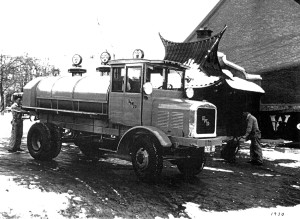About the Author: Robert W. Stieg graduated from the University of Wisconsin in 1940 with a degree in mechanical engineering and started with FWD immediately. He worked there through World War II and became Chief Engineer and Vice President of Engineering. Then, in 1968, he transferred to Mack as Chief Engineer of Special Purpose Vehicles and redesigned their line of all-wheel-drive trucks. For Mack, he designed a new full time, all-wheel-drive transfer case with a patented center differential that Mack used for the next 25 years. He retired in 1988 at age 70. This article was first published in Old Time Trucks back in 2005, and was kindly shared by the editor, Shirley Sponholtz, so that our readers could enjoy it, too. Mr. Stieg has since passed away.
 My son, Philip, gave me a surprise birthday present and made all of the arrangements to drive me to my first American Truck Historical Society (ATHS) national antique truck meet at Syracuse, NY, in 2003. I had a wonderful time, as I had the opportunity to see in real life most of the past truck models I had previously learned about only through sales literature and trucking publications.
My son, Philip, gave me a surprise birthday present and made all of the arrangements to drive me to my first American Truck Historical Society (ATHS) national antique truck meet at Syracuse, NY, in 2003. I had a wonderful time, as I had the opportunity to see in real life most of the past truck models I had previously learned about only through sales literature and trucking publications.
On Friday, we made a stop at the registration building and visited Carl Mantegna’s neat collection of old photographs, to see if he had some old FWD photos that I didn’t have. Having spent years working for FWD, I was especially interested in those trucks. I found several photos that I did not have, but the one printed here made me stop in my tracks. It was shining like a new penny and looked like a Norman Rockwell painting in the Saturday Evening Post. I knew almost everything about FWD trucks from about 1935 on, but this was definitely older and before my time.
I have no idea what the model is. The picture indicates that the truck is brand new, as no customer name had yet been painted on it. The date of 1930 was easily established by reading the Wisconsin license plate.
As a former FWD cab designer, I was fascinated by the square cab with sliding doors and sharp corners in the windows, indicating no stampings. It is the centerpiece of the vehicle’s appearance. It is so prim, proper, and hand-built that it speaks of the era, and must have been designed by Bill Kellet of the Clark Carriage Co. of Oshkosh, WI, where FWD bought their early cabs. I apprenticed to Mr. Kellet in 1940 when FWD bought the Clark Carriage Co.
Note the slight inward curve of the bottom of the door and cab side panel. This would have been difficult to make for a sliding wood-framed door, but it was an example of a deluxe styling feature carried over from the era of elegant horse-drawn carriages. The same applies to the sweeping curved headers at the roof line above the doors and windshield. It adds a touch of style, but its main purpose was probably to give a dome shape to the fabric roof for shedding water. A mild version of the latter treatment was noted on the 1930 Mack BG model at Syracuse.
There was something very familiar to me about the entire scene behind the FWD truck, and I repeatedly went back to study it. It was as if I was viewing a dream sequence of long ago. Then, it all came back when I remembered that Wadham’s filling stations were common in Wisconsin in the 1930s, and there was one in Clintonville, WI, operated by a Mr. Rohde, where my father used to get his gas.
The unusual attraction of these stations was the Chinese pagoda architectural style that these stations used. They had a steep, red tile roof with upturned corners (to skid off evil spirits), just like in this picture. Also, note the good-looking gas pumps with the glass gasoline reservoirs at the top. Mobil must have bought out Wadham’s by 1940, as these Chinese-style gas stations were later replaced with modern-style buildings with a flying red horse on the roof.
But, I also recognized the building in the rear of the photo, as it is the back wall of the Congregational Church I attended for 50 years. Now, it has a huge stained glass window on this face, and the gas station is long gone.
The truck looks brand new because it was probably driven right from the factory, which is less than a mile away. The photo looks carefully orchestrated with two station servicemen perfectly placed on each side. Since Mr. Rohde ran a one-man operation, I suspect that the FWD sales department had arranged the photo for a piece of literature. I was probably near the scene when the picture was taken in 1930, as I was in seventh grade and the school was right across the street in back of the photographer.
What an amazing coincidence that this picture has been wandering around for 73 years and our paths just happened to cross – nearly 700 miles from where we both started! Thanks to Carl Mantegna of Hickory Hills, Illinois, for arranging the photo’s presence in Syracuse.
